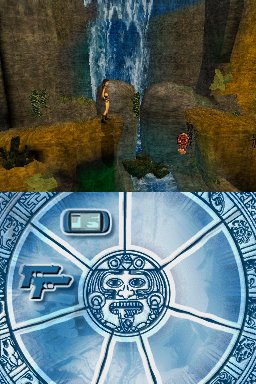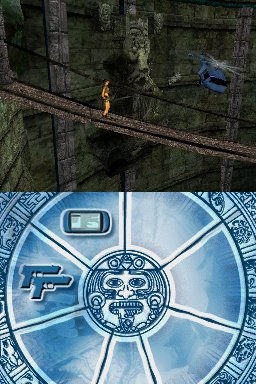Companies haven't made the best effort to really show off the Nintendo DS's 3D capabilities thus far; but, as games like Tomb Raider: Legend prove, the system can push polygons and deliver cinematic experiences on a level that is to equal to the Nintendo 64 or the original Sony PlayStation. Thanks to the game's wicked hot 3D-graphics engine, fans of Lara Croft's adventures can experience the same sort of gunplay and environmental puzzles on the diminutive DS that they've been enjoying for years on consoles and computers. Her twin pistols, high-flying acrobatics, and swimming talents have made it onto a Nintendo DS cartridge relatively intact, as well as the 3D environments and video cutscenes that people have come to associate with the Tomb Raider franchise. While some intermittent gameplay issues occasionally get in the way of enjoying the game, Tomb Raider: Legend is otherwise a slick action adventure that should appeal to anyone who wants to raid tombs and gun down smugglers on the go.

Like the console versions of Legend that were released months ago, Tomb Raider: Legend on the DS follows the exploits of Lara Croft as she investigates the mysterious circumstances of her mother's death some 20 years earlier. Her search begins at an old Incan temple in Bolivia; but, of course, one thing leads to another, and she ends up canvassing various ruins and smuggling dens all over the world to track down the pieces of an ancient sword that is somehow the key to her mommy's demise. While the story mainly serves its purpose--in that it gives Lara an excuse to visit the game's eight different locations--what's impressive is that the game doles out its plot points through a vast number of full-motion video scenes, which employ computer animation and recorded dialogue. Most portable games resort to static pictures and text boxes to keep the story going. In that regard, Tomb Raider: Legend for the DS is presented more like a console game, which does not mean that this version of Legend is identical to its console counterparts. The people, places, and general gameplay are the same, but because the DS lacks the horsepower and storage capacity that the other consoles have, the environments, level layouts, and graphics have been reworked with those limitations in mind. As such, someone who has played one of the console versions, can pick up the Nintendo DS version and feel as if he or she has played two entirely different games.
In terms of the hands-on stuff, most of the game involves searching each environment for clues on how to get from one spot to the next using Lara's many acrobatic abilities. Lara can leap, grab onto ledges, swing on ropes, vault off of horizontal beams, swing between platforms using her magnetic grapple, as well as shimmy across and propel herself upward from sheer handholds. She can also push and pull certain heavy objects, as well as use her guns and grapple to shoot or yank certain environmental decorations, which play into the switch puzzles that you'll come across at regular intervals. Some levels also include swimming or riding a motorcycle that don't require much in the way of thought, but do require quick reflexes to navigate without running out of air or crashing. Falling from a lofty height or getting sliced to bits by a trap can eat away Lara's health and result in death. Thankfully, you can use first-aid packs to regain health, and the only penalty for dying is that you have to restart from the last checkpoint.
Throughout the journey, you'll also encounter hungry tigers and armed smugglers that usually aren't happy to see Lara. Lara carries a pair of pistols that are perfect for such occasions, but she can also pick up and use the shotguns, machine guns, and grenades that dying enemies leave behind. You can make wild shots by repeatedly tapping the fire button or make precise shots by tapping the first-person representation of the enemy that appears on the touch screen. Sometimes, you can grapple or shoot objects in the environment to make them explode or topple on top of enemies. Generally speaking, the puzzles and gunplay never get too complex or furious, but the game shakes things up so frequently that you'll feel like you're always on your toes.

For the most part, the controls are laid out nicely and responsive. Lara turns on a dime and jumps almost immediately. If you push up against a ladder or leap toward a ledge, Lara will latch on automatically. It's also obvious which grapple spots or decorative objects you can interact with because a large button will appear indicating the button that you need to press to activate, yank, or shoot the object. Sometimes the camera doesn't give a good view of the ledge that you need to jump to, but those sorts of "leap of faith" situations are uncommon. Less common but more frustrating is that Lara will occasionally fail to grab onto a rope or a ledge when she's supposed to or will simply let go of a rope or ledge while climbing without any input from you. These collision gaffes probably happen once or twice in each of the game's massive levels, which isn't often enough to ruin the game. But it is frequent enough to make you worry that Lara will fall to her death every time you dangle from a lofty handhold. It's definitely a good thing that levels in the DS game are split into smaller chunks than the levels in the console versions and that checkpoints are more plentiful because it's much easier to swallow an unintended death when you only have to retrace a few steps from the spawn point. It also helps that the gameplay is compelling enough to make it worth tolerating these intermittent flaws.
Besides the diverse gameplay, the other thing that really stands out about Tomb Raider: Legend is that it looks beautiful. The numerous full-motion video scenes are the icing on the cake, but the cake itself is the 3D polygon engine that literally crams PlayStation visuals onto the Nintendo DS. Environments are packed with detail and frequently flaunt animated touches, such as waterfalls and rivers. Weather and lighting effects are rarely seen in Nintendo DS games, but here they're frequently evident. The variety of environments is excellent too. While there are merely eight levels, each one transitions through a handful of indoor and outdoor settings, ranging from jungles and ancient ruins to skyscrapers and mercenary camps. Meanwhile, the third-person camera gives a good view of Lara in her various costumes. She also has a multitude of graceful animations for everything from landing too hard on the ground to vaulting in circles while hanging onto a horizontal beam. The audio isn't nearly as nice, but the dramatic musical pieces and small assortment of gunshots and groans otherwise get the job done. Apart from footsteps, splashes, and the occasional environmental sound, there's just not a whole lot of ambient noise.

Going through the story mode will probably take you about six or seven hours the first time through. It actually feels like it takes longer because each of the game's eight levels is so massive. Every level is split up into 20 or so small sections, and each section only takes about a minute to complete. But when you add all of those sections together, it can take as much as 45 minutes to reach the end of one level. Thankfully, you don't have to finish a level in one sitting. The game automatically saves checkpoint data at the beginning of each section, which means you can quit your game and reload it later without having to retrace too many steps or start the entire level over. After you beat the game, you can play levels again to find any bonus artifacts you missed or to improve your time trial scores. You can use those bonus artifacts to unlock minigames, artwork, and cheats that can be accessed from the extras menu. The minigames are nothing amazing--just Tomb Raider-themed variations of classic logic puzzles. But they do offer a welcome diversion from the main game. There's also a Wi-Fi link mode, but its only benefit is that it lets multiple people merge their time trial scores into a single list.
As a franchise, Tomb Raider is known for its busty heroine and puzzling 3D environments. It's nice to see that those things have been brought to the Nintendo DS without losing much in transition. Tomb Raider: Legend is a gorgeous game, and aside from a few occasions where Lara commits suicide without the player's input, it's also fun to play.